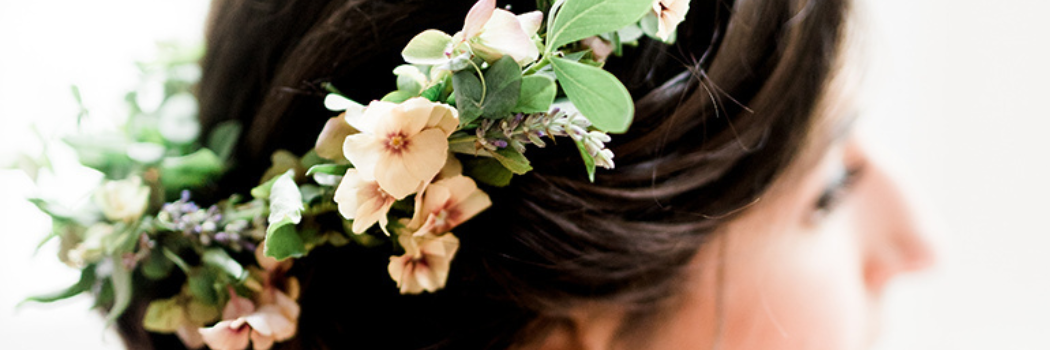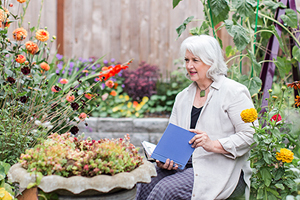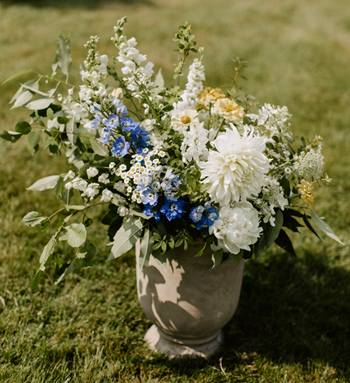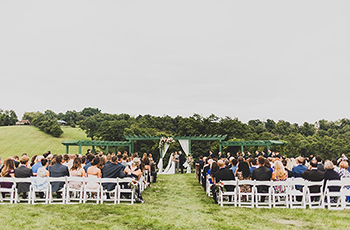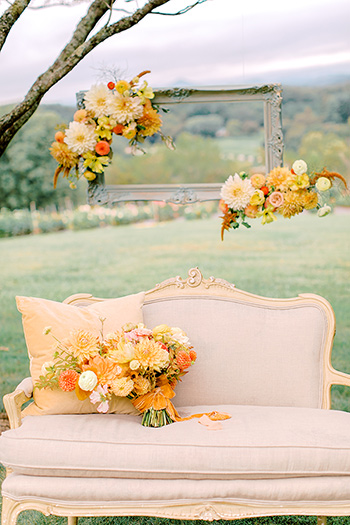- 3 Easy, Reliable, Productive Cut Flowers: Sunflowers, Zinnias & Rudbeckia
- 5 Factors That Determine Vase Life of Cut Flowers
- 2019 American Flowers Week: Combining the Art of Floral Design & Couture
- Celebrate the 7th American Flowers Week | Johnny's 2021 Botanical Couture
- Celebrating the 8th American Flowers Week | Johnny's 2022 Botanical Couture
- Collective Selling Models for Flower Farmers: Flower Hubs That Work
- 5 Cool Flowers to Plant Now | Lisa Mason Ziegler's Secrets for Growing Hardy, Cool-Season Annuals
- Cut-Flower Harvesting & Post-Harvest Care | Best Practices from Pros in the Slow Flower Community
- Cut-Flower Kit | Guide for Market Growers (PDF)
- Easy Cut-Flower Garden Map | For Growers New to Flowers (PDF)
- Easy Cut-Flower Garden Planner | For Growers New to Flowers (PDF)
- From Color to Climate: 5 Floricultural Trends Subtle & Seismic
- Flower Culture by Crop | Comparison Chart | Days to Germination, Weeks to Transplant, Days to Harvest (PDF)
- Flower Farmers' Favorite Fillers & Foliage | Recommendations from 3 Farmer-Florists
- Getting Started in Cut-Flowers | Top 15 Cuts
- Heat & Drought: How Flower Farmers Are Adapting to Changing & Challenging Climatic Conditions
- Introduction to Overwintering Flowers | Guide to Overwintering Flowers
- An Introduction to Producer Marketing Cooperatives | M Lund & Associates
- How Day Length Affects Cut-Flower Production
- Growing Flowers in Hoophouses & High Tunnels: Cool-Weather & Hot-Weather Options
- Starting a U-Pick Flower Farm, From A-to-Z
- Roadside Flower Stand Basics: Success Tips for On-Farm Retail
- Year-Round Flower Production Strategy
- Overwinter Flower Trials | Multiyear Results for 30+ Crops | Johnny's Selected Seeds | XLSX
- Seeding Date Calculator | Johnny's Recommended Flowers for Overwintering | XLSX
- Pricing & Profitability for Flower-Farmers | Pointers from a Diversity of Pros
- Just Add Flowers | An Introduction to Companion Planting for Vegetable & Herb Gardeners
- Sustainable Farming Methods | A Survey of Flower Farmers' Best Practices
- Slow Flowers Palette & Petal Crushes | Evolving Colors & Shape-Shifts in Floral Industry Trends
- Johnny's and Slow Flowers | Johnny's Selected Seeds
- Slow Flowers | Celebrating Fifth-Season Regional Design Elements
- Slow Flowers Floral Forecast | A Summary of Industry Insights & Trends
- Slow Flowers | Building a Better Market Bouquet | Tips & Techniques for Flower Farmers
- Slow Flowers | Tips for Staging On-Farm Floral Workshops | Johnny's Selected Seeds
- Wedding Wisdom 101 | 10 Beginner Tips for Entering the Wedding Floral Landscape
- Succession-Planting Flowers | Scheduling & Planning, Sowing Frequency, Recordkeeping & Recommendations
- Succession-Planting Interval Chart for Flowers
- Sustainable Floral Design | Techniques & Mechanics for Foam-Free Floristry | Tobey Nelson & Debra Prinzing
- Video: Mason Jar Bouquet Tutorial
- Video: How to Build a Bouquet
- Video: Tobey Nelson | Sustainable Floral Design | Slow Flowers Summit
- Video: Economic Considerations in Overwintering Cut Flowers | Johnny's Selected Seeds
- Top 10 Cut-Flower Varieties for Direct Seeding
- Video: Floating Row Cover | Baby "Cool Flower" Protection from Whipping Winter Winds
- Video: The Procona System for All-in-one Flower Harvest, Transport & Display
- Johnny's Overwinter Flowers Tunnel: Trellising, Supports, Ground Cover & Spacing
- Video: Irrigation Considerations for the Overwinter Flowers Tunnel | Johnny's Selected Seeds
- Video: Johnny's Overwinter Flowers Trial Recap
- Video: Producer Cooperatives for Small-Scale Farmers | Johnny's Webinar Series
- Climate Adaptation for Vegetable & Flower Farmers | Johnny's Educational Webinar Resources
- Webinar Slide Deck | New-for-2023 Flowers & Floral Supplies | PDF
- Chrysal Clear Bulb Flower Conditioner | SDS
- Chrysal Professional 2 Transport & Display T-Bag | SDS
- Chrysal Classic Professional 2 Transport & Display (Holding) Solution | SDS
- Webinar Slide Deck | Flower Growing in Southern States | PDF
- Choosing Flower Crops to Overwinter | Guide to Overwintering Flowers
- Edible Flowers List: Top 20 Favorites from the Slow Flowers Community
- Bloom to Boom: Flower Farm Profitability
- Choosing Tulip Varieties for Forcing | Guide to Forcing Flower Bulbs
- Forcing Tulip Bulbs | Guide to Forcing Flower Bulbs
- Snapdragon Groups Explained
- Flowering in the South: Profiles of 5 flower farmers who cope with temperature, humidity, pest & weed pressure
- Video: Flower Growing in Southern States | Johnny's Webinar Series
- 10 Tips for Building a Profitable Cut-Flower Business
- Introduction to Forcing Flower Bulbs in Soil | Guide to Forcing Flower Bulbs
- U-Pick Power for Your Flower Farm | Johnny's Webinar Series
- Eat Your Flowers: Serve Up That Wow Factor With Edible Flowers
- Flower Growing in Southern States | Johnny's Educational Webinar Series
- Chrysal CVBN Flower Conditioner | SDS
- Chrysal Clear Bulb T-Bag | Cut-Flower Conditioner | SDS
- Chrysal Professional 1 Hydration Solution | SDS
- Chrysal Professional 3 Vase Solution Powder | SDS
- When to Start Seeds for Overwintered Flowers | Guide to Overwintering Flowers
- Chrysal Clear Universal Flower Conditioner | SDS
Wedding Wisdom 101
By Debra Prinzing, Slow Flowers Society
10 Tips for Entering the Wedding Floral Landscape
According to The Wedding Report, the average cost of a U.S. wedding currently approaches $25K. How can your farm or flowers attract a portion of that budget?
1 • Design a Wedding Program That Works for You & Your Farm
I've been writing about the flowering of weddings for the past decade and have come to agree with the general consensus that the largest single floral "spend" for most people is to commemorate and celebrate marriage. For this report, I surveyed a cross-section of flower farmers to learn whether and how weddings are a facet of their mix of products or services. What I heard was that while there is no singular best approach, what is most important is that you… design a wedding program that works for you and your farm.
Here are the main ways the Slow Flowers community is generating wedding revenue:
- Selling bulk flowers to do-it-yourself (DIY) couples
- Selling add-on design services to DIY couples
- Designing full-service wedding florals
- Using your farm as a venue for weddings and events
- Selling wholesale to wedding and event florists
We aren't able to fully explore all these income-generating opportunities in this month's Wedding Wisdom roundup, but the insights collected here offer a good starting point. Look for future articles as we expand on some of the topics in this initial report.
2 • Gate Pass Entry: If You Grow It, They Will Come
Take a cue from the many floralpreneurs who have indeed made weddings work for their farm. If you have not yet sold your flowers to a couple, chances are, you will be asked.
The farmers' market stall presents a low-pressure scenario for getting started. Lisa Larsen of Sunborn Gardens in Mt. Horeb, Wisconsin, told me in a recent Slow Flowers Podcast episode that 30% of the weddings she designs come from inquiries at her stall at the Dane County Farmers' Market in Madison.
"These are people who have loved us over time," she says. "I'll hear, 'I come every week with my boyfriend, and I always wanted your flowers for my wedding.' Those are my favorite stories because I know they already love my work, so I won't have to sell too hard," she says.
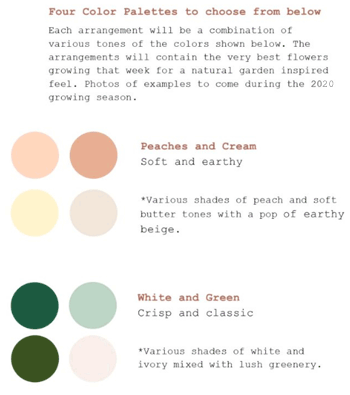
Sunborn couples choose from several seasonal color palettes: Peaches & Cream, White & Green, or Bold & Bohemian, for example.
Having a strong online presence with a website and active social media channels like Instagram is equally important for attracting couples, Larsen adds. It's important to know what type of client you want.
"I tell couples, 'You have to be flexible on the flower choices or I'm not for you.' We try to make that as clear as possible on our website. This is a little outside the box for some couples. 'We're at the mercy of the seasons to some extent, so in September, you're going to have to have dahlias as your focus flower.' If they want a certain color, or a certain style — classic or wild — we can work with that. It took me a long while to learn how to sell it that way."
Besides full-service wedding design, Sunborn offers an À la Carte Seasonal floral program. Streamlined, with limited options, it's presented on the farm's website with charming line drawings illustrating each floral item and price — from a $14 boutonnière or $165 bridal bouquet to a small arrangement for $35 (image above). Couples choose from one of four color palettes that Larsen has designed (image below).
"This is for people who want pretty flowers, maybe who don't have a lot of money, and we want it to be accessible to everybody. People like Hans and me when we got married," she explains. "I'm noticing it's super popular this year."
3 • Offer a Tiered Menu of Services
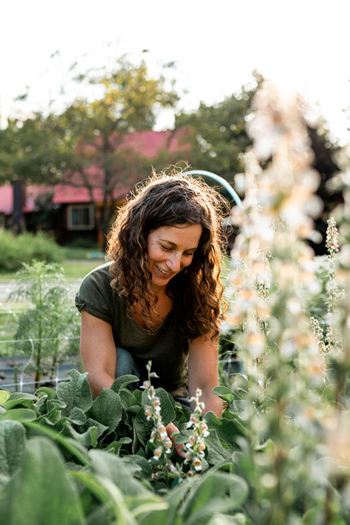
Melissa Hessney Masters of Tanglebloom offers a 3-tiered wedding floral menu designed with clients' varying needs in mind. Photo: Krystina Olsen
For beginners, a bulk or "bucket flower" program is an easy, low-risk way to experiment with the wedding category, say experienced flower growers. Not only do couples love the chance to buy farm-direct blooms, but farms also enjoy volume sales. It also allows growers to learn as they go, on their own terms.
At Tanglebloom in southern Vermont, Melissa Hessney Masters grows flowers with her wedding clients in mind. The farm offers 3 levels for wedding and event flowers: full-service, à la carte, and DIY.
- Full-Service Wedding
A full-service wedding "is what people usually associate with wedding florists," says Masters. Priced at $4K or higher, this service involves working with the wedding couple throughout the planning process. "It also means my team and I will deliver, set up, and break down all the event's floral elements — including installations and larger designs such as arbors or arches, garlands and urns," she says.
- À la Carte Floral Offerings
When Masters became a new mother a few years ago, she focused more on à la carte floral offerings. "With this service level, couples can order their personal flowers (items carried or worn) from a set menu — bouquets, boutonnieères, and flower crowns. We work within the desired color palette but do not promise specific varieties or create delicate designs that are a travel risk (like cascading bouquets). In this way, we can meet the demand for smaller and lower-budget weddings while still offering local flowers. Streamlining the offerings and process assures profit for the farmer-florist. And couples can expect to spend $1.5K to $2K with this option," she says.
- DIY
The DIY wedding customer is typically interested in creating either all or a portion of their wedding florals. This option is ideal for backyard ceremonies or shoestring budgets, Masters explains. "Couples can purchase buckets of mixed seasonal flowers, or pay a little more to specify colors, with most wedding parties spending $500 to $1K. Either way, it's an affordable option that ensures local flowers are accessible."
Often, couples will ask Tanglebloom to design their personal flowers, while they create their own centerpieces with the bulk blooms.
Farmer-florists can offer any or all of these flower service levels to fit the needs of their own farm's schedule, ability, and market, Masters says.
"By being selective and intentional with our offerings, we can assure that locally-grown flowers are profitable and simultaneously accessible to almost anyone for their wedding or event. And that is worth celebrating."
4 • Getting to Know You: Consultations with Farm Tour
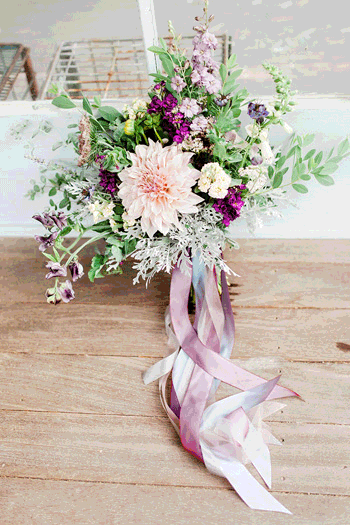
Cassie Plummer has designed the hybrid Jig-Bee We Do package with options for adding on wedding personals and ceremony installations. Photo: Haley Richter Photography
Cassie Plummer of Jig-Bee Flowers in Philadelphia has several ways for couples to buy direct from her farm, beginning with the $145 DIY bucket containing at least 60 stems and a mix of focal flowers, accent flowers, and foliages.
For clients who want more design assistance, she developed the "We Do" package, "with the option to add on wedding personals and ceremony installations." This program is typically priced between $600 to $2.5K, with pricing depending on the size of the wedding party and ceremony/reception needs.
"When we first started working with DIY couples, we asked for a color palette and the quantity of buckets they wanted. We were trying to keep it economical for the couples and simple for us to put the buckets together," she explains. "But I found that couples were asking a lot of questions or may have had specific, premium flower requests. In addition, our consults did not dive deep into their decorating plan, so I didn't know what flowers and foliage to give them. It didn't feel good to say, 'It's DIY, you figure it out.' "
Introduced three seasons ago, the "We Do" package is a great hybrid model, Plummer says. "I increased the price of our bulk buckets, with the offer to add on wedding personals. New this year, we are offering to do installations as part of that package. In our initial consult, we dive deeply into the couple's plan, including their color palette. I also come up with a recommended number of flowers for the bulk purchase, and I quote out any personals they want. I still don't promise specific flowers, but I do ask them what flowers they love."
Once couples book with Jig-Bee, Plummer offers two additional consults, one of which includes a farm tour right before their wedding. "At these consults, we talk through their decorating plans and offer tips to help it all go smoothly. During the farm tour, couples learn a little bit about our farm practices and we walk through the fields, talking about the flowers and foliage that we most likely will be providing for their wedding. We also try to send them home with a mini-bouquet of the flowers they were drawn to during the tour."
The program is gaining popularity, "and it is really on-trend for creating experiences," Plummer says. "The process works for me because with the higher price on our mixed buckets, I'm covering the costs of my time and I send them out with flowers and foliage that I know will work for their ceremony. Plus, we aren't competing with the florists who buy wholesale from us, because they don't offer this service."
5 • Educate Your Market
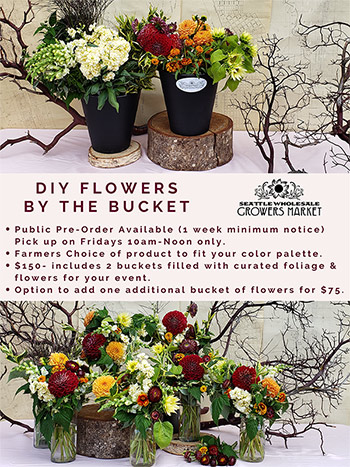
At Seattle Wholesale Growers Market, the DIY Flowers by the Bucket program serves both shoppers and professional florists. Shoppers can request a specific palette up to a week in advance, then a "curated foliage & flowers" selection is made by SWGM staff. Photo: Seattle Wholesale Growers Market
At the Seattle Wholesale Growers Market, a farmer-to-florist cooperative, care has been taken to develop a DIY wedding sales channel which supports and upholds the professional florists who make up the core of the co-op's customer base.
Typically, the market has opened to the public from 10am to noon on Fridays. But demand has continued to grow as more couples ask to shop for their wedding flowers.
Last fall, the staff and board piloted DIY Flowers by the Bucket, and the program is now in place for 2020. It aims to make it easier for the public to shop at SWGM, by allowing DIY shoppers to request a specific palette up to one week in advance. The "curated foliage and flowers" selection is determined by SWGM staff, and there is a $150 minimum for two buckets, with additional buckets priced at $75 each.
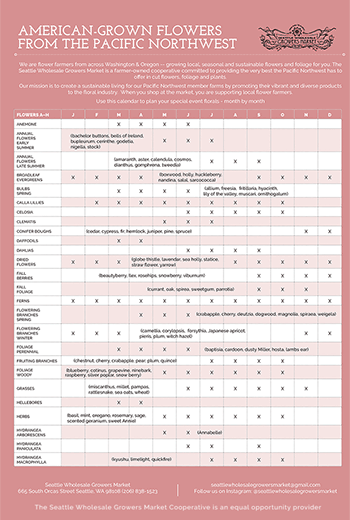
The market's new Flowers by the Month Calendar helps DIY wedding customers understand bloom time and peak harvest of 200-plus flowers, foliages, and branches, month-by-month. Photo: Seattle Wholesale Growers Market
Selling to the public helps inform consumers about the value of locally-grown, seasonal wedding flowers, says Diane Szukovathy, SWGM board chair and co-owner of Jello Mold Farm in Mt. Vernon, Washington. "By educating consumers on the amazing array of seasonally-diverse flowers and foliage that our local farms produce, we support everyone in the 'floral food chain' — from bumblebees to florists to seed-sellers."
SWGM is currently managing a 1-year USDA grant to develop new markets, which allowed funding of a consumer-facing educational program. [Full disclosure: The author is administering this project as part of the grant.]
Working with the flower farmers and staff, and using buyer's card florists as a resource, the SWGM has recently developed a monthly lecture/demonstration open to the public. Called the "Best-of Series," it features signature flower crops by season, educates DIY customers eager for inspiration, and showcases the design work of top florists who shop at the co-op.
A giveaway at these events is a new "flower calendar," which helps DIY wedding customers understand bloom time and peak harvest of 200-plus flowers, foliages, and branches, month-by-month. At the January 2020 Seattle Wedding Show, SWGM handed out hundreds of the calendars and also promoted the DIY Flowers-by-the-Bucket program and the monthly lecture series.
These tools are being used in an ongoing fashion to help connect and educate the public about the beauty, freshness, and value of local flowers, Szukovathy says.
6 • Manage Budgets & Expectations
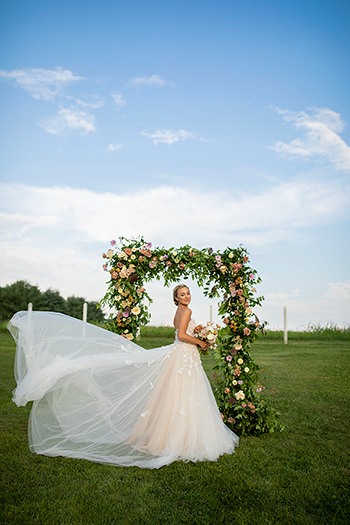
Nicolette Irving of Flourish Flower Farm educates prospective wedding couples about cost, then lets them do the decision-making. Photo: Christy Johnston for BHLDN at Flourish Flower Farm
Nicolette Irving of Asheville, North Carolina-based Flourish Flower Farm offers a Farmer's Choice option to wedding customers. "This is a less-customized option that we offer seasonally, and it does not have a minimum (we have a $3.5K minimum for full-service weddings). Couples choose between two color palettes for pieces such as the bridal bouquet, boutonnières, and centerpieces. We do not handle installations such as arbors or table garlands as part of these packages. Delivery is an option, but couples can also pick up from the farm during specific hours."
Irving has a goal of educating prospective couples about the cost of wedding flowers and then letting them do the decision-making. For example, in serving the "Pinterest Bride" (a somewhat dreaded term in floristry that refers to a customer whose expectations exceed their means), "we make an estimate of what everything on their wish list would cost, then acknowledge that the estimate is over budget," Irving says. "We give suggestions on how to scale back, prioritize, or adjust the proposal to get it closer to their budget without compromising the aesthetic they are hoping to achieve."
If the couple has many attendants, she may suggest a petite posy instead of a full bridesmaid bouquet. When a client's Pinterest board includes lavish floral arbor ideas that would break most budgets, the farmer-florist presents options:
- The Pinterest arbor is $2.5K (or whatever the case may be); OR
- Flourish will design a smaller arbor with two lush, asymmetrical "swags" for $700.
Irving recently wrote a blog post on How to Maximize your Floral Budget, addressing the question of "why wedding flowers cost what they do." She shares a link to this useful resource as a follow-up to consultations.
7 • Know Your Sweet Spot
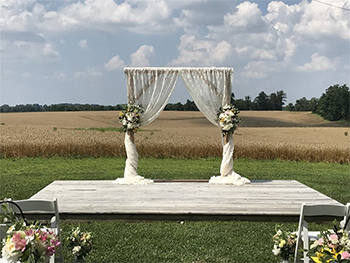
Finding your sweet spot is important for wedding floral designers, especially to gain a foothold. "Of course we take smaller weddings and even larger ones, but we know our market and we stick with it," says Martha White of Free Range Flowers. Photo: Ryan Zarichnak Photography
Martha White and David Martin of Free Range Flowers at Martin Farm in Gracey, Kentucky, offer buckets of flowers for the DIY couple as well as full-service floral design. Their best channel of new business comes from a relationship with a local wedding venue owner, White says. "She has served as a mentor, encourager, and promoter for us and our flowers for five years now, and many of our weddings come from her recommendations."
The venue owner also helped White and Martin zero in on Free Range Flowers' target customer. "We live in a rural, agricultural, working-class community, and we've realized we are not going after big-budget brides. We can make a good living on $2K to $3K floral budgets," says White. "That is our sweet spot. Of course we take smaller weddings and even larger ones, but we know our market and we stick with it. My husband and I enjoy working together, and we have no interest in expansion or hiring more people. Knowing this helps us refine our message, tailor our products, and set reasonable pricing — and keeps us focused."
Free Range Flowers offers couples a handy Wedding Flower Cost Calculator, to help them determine what their budget will cover. It's based on entering the specific number of items needed — from boutonnières to the "toss bouquet."
Over time, White says she's learned how to set appropriate pricing for her wedding products. "I learned from an experienced floral designer that if I charge correctly, I won't resent jobs I dread, like climbing a ladder to install an arbor or arch because of my fear of heights," she confides. "I often think, 'What is the minimum I'd have to charge to not feel resentful of my time?' That has changed the way we look at the work we do. And just to make sure we aren't crazy, we do compare prices with other floral designers and traditional florists to make sure we aren't out of line in our area. We aren't the cheapest but we aren't the most expensive. That's right where I like to be!"
8 • Offer Flowers Plus Venue
Renting your flower farm as a wedding venue requires a big leap for many flower farmers. At Destiny Hill Farm in Washington, Pennsylvania, outside Pittsburgh, the idea took hold when owners Nancy and Jim Cameron purchased Nancy's grandparents' dairy farm. "We asked ourselves, 'What do we do with this 137 acres?' " she recalls.
The couple signed up for an agricultural business course with Penn State Extension, and in 2011, Destiny Hill Farm was born as a lavender, fresh-cut flower, and berry farm, as well as a seasonal event center hosting large weddings and corporate events. Destiny Hill also has a full-service floral design studio incorporating the farm's fresh-cut flowers.
According to Nancy, "We learned from our classes at Penn State Extension that farming is really hard work and that we should seriously consider some form of agritourism."
Nancy credits much of the success of Destiny Hill to employing a professional event coordinator who manages everything from inquiries to day-of coordination. The farm hosted two weddings in 2011 and is currently booking about 20 weddings each season. That number stays consistent because Destiny Hill only books one event per weekend, Nancy says.
The lavender fields serve as backdrop to the outdoor ceremony; the lawn and stable play host to reception and cocktails; and the show barn converts to a ballroom that can accommodate 170 to 400 guests for dinner and dancing, as well as providing an indoor ceremony option during inclement weather.
When couples book Destiny Hill for their wedding, they are encouraged to work with the farm's design studio, although it's not a requirement. Many want to walk through the flower fields and see what's growing there. "For the educated couple, they one-hundred-percent want to use our flowers," Nancy says.
9 • Stay True to Your Values & Mission
The most sage advice I heard while corresponding with growers for whom weddings are a portion of their farm income comes from Stacy Brenner, co-founder of Broadturn Farm in Scarborough, Maine. Broadturn offers full-service, year-round floral design, a DIY bulk floral program, and a hybrid of the two. The farm and its barn are also rented as a venue for weddings with up to 200 guests. Starting in 2019, Broadturn instituted a "zero waste" policy for weddings, writing this explanation on its website:
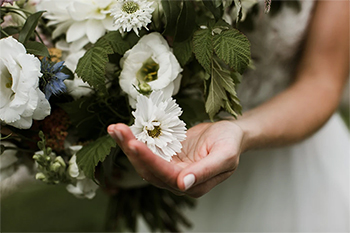
Broadturn Farm in Scarborough, Maine has instituted a zero-waste policy for weddings. Photo: Broadturn Farm.
"This means no plastic straws, no bottled water, no compostable dishware (which doesn’t break down in our compost pile!), no plastic cups, etc. After 15 years in the wedding industry, we are done with big trips to the dump to unload wedding refuse. We are happy to help you plan an event that has limited waste and together we can all feel good about being part of the solution."
Brenner says if you truly want to engage in farm-driven floral design, it takes effort and intention. "Offer your clients a floral plan that can be looked at through the lens of climate change and social impact as it relates to your ecosystem, your local community, and a healthy workforce," she says. "Start by never promising a design will have specific blooms. This promise limits your flower choices and hems you in, to search for things that may not be available in your region due to weather or crop failure. Tell your client you can meet their palette needs and the aesthetic of the conceived design with what is available in the fields or forest locally. Drive the conversation so that it is about a beauty proposition as it relates to the natural world."
Brenner believes that true florist-farmer collaborations are possible when you spend time building relationships with other farmers and designers so you can better understand each other's businesses. "Our world and our clients deserve to have the industry move forward. Let's all make it trendy to go to bed at night and know our design businesses and our flower farms are doing everything they can to make the world a more beautiful place while mitigating climate change as much as possible."
No matter how many weddings you may have under your belt — none yet, or many more than most — you simply couldn't adopt greater wisdom than this.
10 • Tell Me a Little More About Yourself (Keep Learning!)
If an income stream from wedding floral design is one you're committed to exploring, you'll find the market to be a dynamic, challenging one, with limitless creative potential — no matter your scale or geographic locale. Though there is no one best way to enter that marketplace, if you take it a step at a time you will find a path that fits your process, your farm, and your values. Even if the wedding landscape is uncharted territory for you, a stepwise approach is one that will allow you to establish your footing, gain ground, and carve out your niche in this rewarding field.
More Resources
- 5 Factors That Determine the Vase Life of Cut Flowers • Article
- Cut-Flower Harvesting & Post-Harvest Care• Article
- Flower Farmers' Favorite Fillers & Foliage• Article
- Sustainable Floral Design • Better-Choice Mechanics & Techniques for Foam-Free Floristry • Article
- Succession-Planting Interval Chart for Flowers• Article
- Shop Flowers by Color


